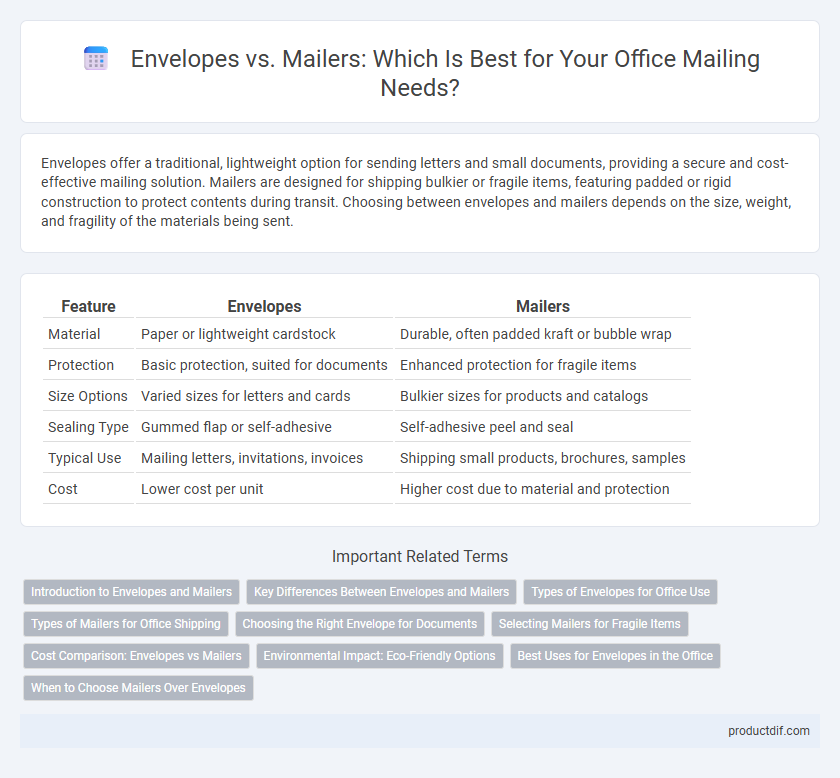Envelopes offer a traditional, lightweight option for sending letters and small documents, providing a secure and cost-effective mailing solution. Mailers are designed for shipping bulkier or fragile items, featuring padded or rigid construction to protect contents during transit. Choosing between envelopes and mailers depends on the size, weight, and fragility of the materials being sent.
Table of Comparison
| Feature | Envelopes | Mailers |
|---|---|---|
| Material | Paper or lightweight cardstock | Durable, often padded kraft or bubble wrap |
| Protection | Basic protection, suited for documents | Enhanced protection for fragile items |
| Size Options | Varied sizes for letters and cards | Bulkier sizes for products and catalogs |
| Sealing Type | Gummed flap or self-adhesive | Self-adhesive peel and seal |
| Typical Use | Mailing letters, invitations, invoices | Shipping small products, brochures, samples |
| Cost | Lower cost per unit | Higher cost due to material and protection |
Introduction to Envelopes and Mailers
Envelopes and mailers serve distinct purposes in office supply for document and product shipping. Envelopes are typically made of paper and designed to hold flat, lightweight contents such as letters and small documents. Mailers, often constructed from thicker materials like cardboard or padded paper, offer enhanced protection for bulkier or fragile items during transit.
Key Differences Between Envelopes and Mailers
Envelopes are typically flat, lightweight, and designed for standard documents or letters, offering a secure and professional way to send correspondence. Mailers, on the other hand, are padded or rigid, providing extra protection for bulkier or fragile items such as small products or marketing materials. Key differences include thickness, durability, and intended use, with mailers often featuring bubble lining or cardboard for enhanced protection compared to the thinner, flexible structure of envelopes.
Types of Envelopes for Office Use
Standard office envelopes include #10 business envelopes, catalog envelopes, and window envelopes, each designed for specific mailing needs. #10 envelopes, measuring 4 1/8 x 9 1/2 inches, are ideal for business letters and invoices, while catalog envelopes offer larger sizes such as 9 x 12 inches to accommodate bulkier documents. Window envelopes feature transparent panels to display addresses, streamlining mailing processes and reducing the need for labels.
Types of Mailers for Office Shipping
Padded mailers, bubble mailers, and poly mailers are the most common types of mailers used for office shipping, offering varying levels of protection and durability for different items. Padded mailers provide cushioning for fragile items, while poly mailers are lightweight, water-resistant, and ideal for shipping documents or non-breakable goods. Bubble mailers combine the benefits of padding and lightweight materials, making them a versatile choice for secure office shipments.
Choosing the Right Envelope for Documents
Selecting the right envelope for documents depends on size, protection needs, and mailing method. Traditional envelopes suit letters and flat documents, while padded mailers provide extra cushioning for fragile or bulkier items. Choosing envelopes with appropriate dimensions and thickness ensures secure delivery and professional presentation.
Selecting Mailers for Fragile Items
Rigid mailers provide superior protection for fragile items due to their sturdy construction and impact resistance, reducing the risk of damage during shipping. Padded mailers with bubble wrap interior cushioning offer additional shock absorption, ideal for delicate objects like electronics or glassware. Choosing mailers over standard envelopes ensures enhanced safety, secure sealing options, and professional presentation for sensitive office supplies.
Cost Comparison: Envelopes vs Mailers
Envelopes typically cost less than mailers, with standard business envelopes averaging around $0.03 to $0.10 each, while padded or specialty mailers range from $0.15 to $0.50 per unit, depending on size and material. Bulk purchasing further decreases envelope prices, making them more economical for large mailing volumes, whereas mailers offer added protection but at a higher expense. Factoring in shipping weight, envelopes usually incur lower postage costs compared to heavier mailers, impacting the overall mailing budget.
Environmental Impact: Eco-Friendly Options
Envelopes made from recycled paper or biodegradable materials offer a lower environmental footprint compared to traditional mailers, which often rely on plastic or mixed materials that are harder to recycle. Eco-friendly mailers crafted from compostable plant fibers provide a sustainable alternative, reducing landfill waste and promoting circular economy practices. Choosing envelopes or mailers certified by environmental organizations, such as FSC or Biodegradable Products Institute, ensures responsible sourcing and disposal aligned with green office supply standards.
Best Uses for Envelopes in the Office
Envelopes are ideal for securely sending letters, invoices, and smaller documents within the office or through postal services, offering protection from bending and damage. Their various sizes and secure closures make them perfect for organizing confidential correspondence and maintaining professional presentation. Envelopes are essential for mailing tasks that require a neat, formal appearance and efficient handling of paper-based communications.
When to Choose Mailers Over Envelopes
Choose mailers over envelopes when shipping bulky, fragile, or irregularly shaped items that require extra protection and cushioning during transit. Mailers offer padded interiors and durable materials, ensuring contents arrive safely without damage. Use envelopes for lightweight, flat documents or correspondence that do not need additional protection.
Envelopes vs Mailers Infographic

 productdif.com
productdif.com